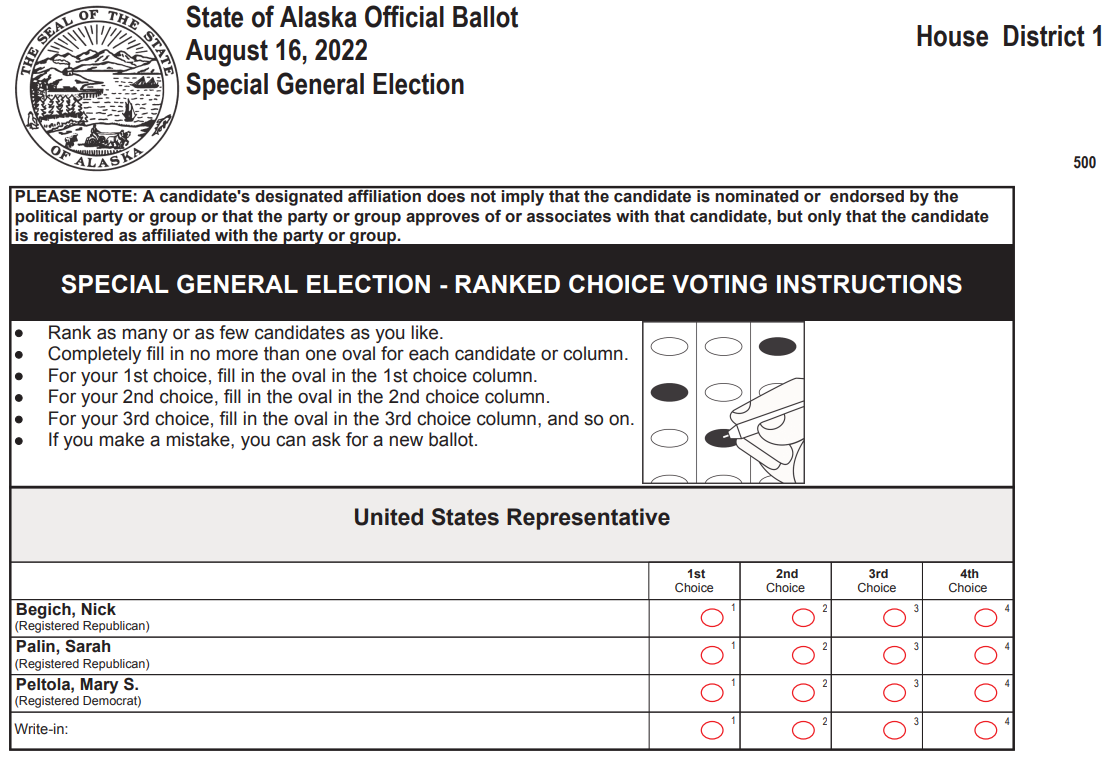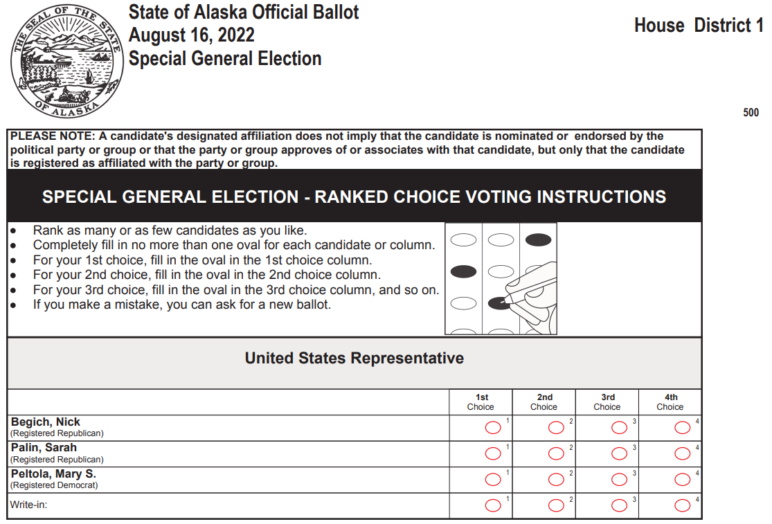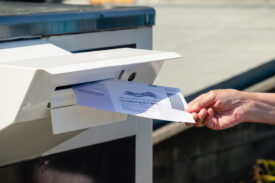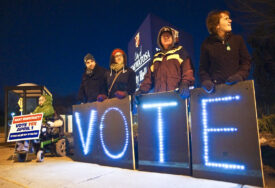For a country bogged down by political polarization, the run-up to Alaska’s first ranked choice election might seem refreshing: a Democrat talking openly about family ties to a Republican Congressman; a Republican giving shout-outs to union members; and voters with the power to rank candidates from the opposing party.
The upsides of weighing both sides may not exist in every ranked choice election, but they do in this one.

In Alaska’s special election to serve out the term of late US House Representative Don Young, cross-party outreach has clear benefits for both voters and candidates. The upsides of weighing both sides may not exist in every ranked choice election, but they do in this one. The two Republicans and one Democrat in the race all have paths to victory made all the more viable by courting voters from both parties. And voters have the opportunity to rank all three candidates, meaning they shouldn’t immediately write off candidates from the opposing side.
Candidate and voter behavior in Alaska so far bolsters the theory that ranked choice voting, at least in certain elections, can to some degree counter polarization. If applied more widely, could ranked choice voting be part of a cure for hyperpartisanship? If so, more moderate cohorts of lawmakers might make more progress on issues voters care about, like reducing the high cost of health care and improving educational opportunities.
This article looks at the following: Where is there room for bipartisan behavior in Alaska’s special general election for US House? Does it actually make sense for voters? How are Republicans Nick Begich and Sarah Palin, and Democrat Mary Peltola courting voters from the other side? And what could it all imply for American democracy?
For Democratic voters, ranking a Republican second isn’t a terrible idea
In ranked choice voting, voters rank candidates from most- to least-favorite. In Round 1, any candidate who wins a majority of first-place votes wins. If no one secures such a majority, the last-place candidate exits the race and a new round begins. In Round 2, the second-place votes from the ballots of the candidate defeated in Round 1 get redistributed among the remaining candidates. The process continues until a candidate secures a majority of the votes.
A ranked ballot affords voters more power to influence the results than they would in the typical American election, where each voter chooses just one candidate and the candidate with the most votes wins. The option to rank expands voting power. Even if your favorite candidate loses, your next-favorite candidate can get your vote.
And yet, some Alaska progressives are talking about voting for the lone Democrat only and not ranking either of the two Republicans. Viewed one way, that strategy makes sense, at least for the House special election.
Here’s why: The Democrat, Peltola, likely will secure about 40 percent1 of first round votes, enough to send her to Round 2. The two Republican candidates, Begich and Palin, will split the remaining 60 percent. That means either Begich or Palin will leave the field in Round 1. The other will advance with Peltola to Round 2.
Here’s where ranked choice voting kicks in. The voters who chose the Round 1 loser as their No. 1 and ranked another candidate second will remain in the game. In fact, their second-choice votes will decide the election. In this scenario, where Peltola advances to Round 2, her supporters’ second choices won’t ever come into play. With three candidates in the race, the election will end in Round 2.
Peltola supporters lose nothing by ranking a Republican second. But if she’s out in Round 1, they’ll have a say over who wins rather than letting other voters choose for them.

But if Peltola somehow loses in the first round, those of her supporters who failed to rank a second candidate will have forfeited a plum chance to influence the election. Ranking Peltola first and a Republican second would NOT allow the Republican to beat Peltola as long as she’s still in the race.
Again, Peltola supporters lose nothing by ranking a Republican second. But if she’s out in Round 1, they’ll have a say over who wins rather than letting other voters choose for them.
Republican candidates are flirting with Democratic voters, but are they serious?
Without a ranked choice system, the two Republicans, Begich and Palin, may well have split the conservative vote, allowing Democrat Peltola to win. But the ranked choice format means the odds favor a Republican win. The question is, which one?
Begich and Palin are in a dead heat for Round 1 votes, and they know it. Chances are only one of them will advance to the second round, no matter how you slice the roughly 60 percent of likely Republican voters in the Alaska electorate.2 The Republican who makes it to Round 2 has a very good chance of winning. Given the stakes, their campaigns have opted to attack each other, while winking at likely Peltola voters.
Begich, who has the Alaska Republican Party’s endorsement, released a negative ad in mid-July focused on Palin’s decision to leave the governor’s office before her term was up. It also featured photos of her in a pink-and-blue bear costume on the reality show “The Masked Singer” performing Sir Mix-A-Lot’s 1992 hit “Baby Got Back.”
“Sarah Palin is a quitter,” the ad says. “We picked her to do a job, and she didn’t bother to finish it because she wanted to go out and get rich and famous.” The ad pokes fun at former President Donald Trump’s endorsement of Palin at a July rally in Anchorage, using audio of Trump railing against quitters.
The ad has a bipartisan audience: the Republican Party establishment, which shunned Palin and endorsed Begich, and also progressives, who detest Palin for her support of Trump and her attacks on former President Barack Obama.
Palin struck back in an interview with political blogger Jeff Landfield, positioning herself as a seasoned Alaska politician and Begich as a Johnny-come-lately.
“Nobody’s asking this guy: How long have you been in Alaska? How come I’ve never heard of you before?” she said. “I’ve been in Alaska politics for thirty years. … I so want to have a debate with the young man to find out more about who are you? What do you stand for?”
Palin also questioned Begich’s fealty to the Republican cause, pointing to his vote for former Anchorage Mayor Ethan Berkowitz, a progressive. “I’ve spent the last decade-and-a-half getting Republicans elected all over this country. What has he done? He’s gotten Democrats elected. He’s admitted that.”
Palin, like Begich, is subtly fishing for votes outside the Republican pool. She gave a shout-out to union members, a traditionally Democratic constituency that has shifted somewhat to the right, at the close of the interview. The union play is an old one for Palin, where she zeroes in on the fact that while union leaders tend to be progressive, members are politically mixed. “I tell you our brothers and sisters in the union, they are common-sense, hardworking Alaskans,” she said to Landfield. “Unfortunately, sometimes there are some union leadership that are kind of thugs and it gives unions a bad name, but the brothers and sisters, love ‘em.”
Republican voters are free to rank a Democrat second
Alaska’s Republican Party is urging voters to “rank the red,” in hopes that no second-place votes go to Democrat Peltola. Despite Palin’s long history of antagonizing Alaska’s Republican establishment, party officials still prefer her to a Democrat. “Masked Singer” attack ads aside, Begich himself said he’d rank her second during a June candidate forum in Anchorage. (Palin and Peltola would not say who they’d be ranking second.)
But voters might have other ideas. Moderate Republicans who could tolerate a Democrat in office could ignore the party line and rank Peltola second. Absent an Independent candidate in the race, voters who don’t identify strongly with either party could express their views by also ranking a Republican first and a Democrat second (or vice versa).
…figuring out where you might actually agree (or partially agree) with a candidate and letting them know exactly why you might consider supporting them is a chance to exercise influence in a ranked choice system.

Of course, not everyone can bring themselves to vote across party lines. The political system Americans have chosen has conditioned voters to choose a team and stick to it. But figuring out where you might actually agree (or partially agree) with a candidate and letting them know exactly why you might consider supporting them is a chance to exercise influence in a ranked choice system.
Given that the votes of the losing Republican will most likely decide the election in Round 2, Peltola has been making the case to the voters who rank a Republican first for why they should choose her second.
In a June interview with Landfield, Peltola spoke at length about her Republican father’s friendship with Young and how her parents worked to get Young elected. “I think he’s smiling down on us, getting a kick out of the whole thing,” she said of Young. Peltola also spoke well of Palin, whose two years as governor coincided with Peltola’s final two years in the House. Both were pregnant, family women in public service and “worked very well together,” Peltola said.
Should Peltola win on Independent votes, those voters would have a say over how she operates in Congress. She might be a Democrat with an independent streak—the inverse of Alaska Senator Lisa Murkowski, the rare Senate Republican who occasionally votes with Democrats. Already, for instance, Peltola has said she supports a proposed ConocoPhillips oil development in the National Petroleum Reserve-Alaska and is open to drilling in the contested 1002 area of the Arctic National Wildlife Refuge. Her pro-drilling stance is typical of Alaska Democrats and likely unaffected by the new ranked choice system. Former Alaska US Senator Mark Begich, a Democrat (and uncle of the Republican candidate Nick Begich), also supported drilling in the refuge.
We’ll see what happens in November
Does ranked choice voting typically reward bipartisan behavior? Or are the candidates and political dynamics in Alaska’s US House race somehow exceptional? The regular general election for the full two-year House term in November will likely see the same three candidates on the ballot, plus a fourth. Will the cross-party calculus change with the addition of another candidate? (Four candidates were supposed to compete in the special election, but Independent Al Gross dropped out just weeks after clinching one of the spots. State election law barred the fifth-place finisher in the primary, Republican Tara Sweeney, from taking his place.) And what role will across-the-aisle strategies play in Alaska’s races for US Senate and governor?
Politicians shouldn’t face punishment for working constructively across party lines.

US democracy can’t function properly without multiple voices and a healthy amount of tension. But Americans have slid so far apart that a course correction is in order. Although election reforms like open primaries, ranked choice voting, and proportional representation can help, no voting system can completely overcome the powerful interests that have driven Americans into two camps. Addressing the sour discourse promoted by social media platforms, media pundits, religious groups, and the major political parties might yield even greater improvements.
Whatever the fix, the goals seem clear. Politicians shouldn’t face punishment for working constructively across party lines. Voters should have more than two mutually hostile ideologies to choose from. And party platforms should function as guides, not constraints—and definitely not as rhetorical tools for upending democracy itself.










